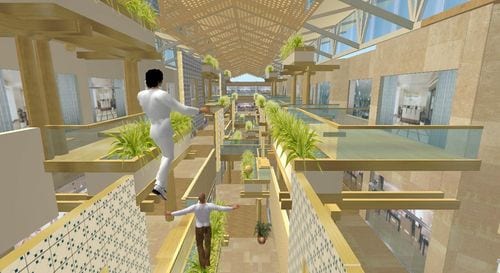Local Architect Uses Second Life to Build and Showcase Models

Photo: David Denton on Facebook
Retired architect David Denton has found a novel use for the game Second Life: building and showcasing models of his architectural projects.
The idea came to him 18 years ago after being diagnosed with Parkinson’s disease, a nervous system disorder that affects motor function. Denton was designing a shopping mall in Cairo and the constant travel was taking a toll on him. “It dawned on me one day that we could be doing the project in the virtual world,” he said in an interview.
Making the game a part of his workflow and life has allowed Denton to work on projects and collaborate more easily, all while also offering his clients a unique and improved experience.
“When I first presented the design to the client in Cairo I did not show him any drawings at all.”
Denton landed on Second Life for his work after discovering it while searching for ways to cope with his diagnosis. He created a digital model of the mall from home and flew out to show his client using some virtual reality headsets. “When I first presented the design to the client in Cairo I did not show him any drawings at all. I just took him in and let him walk around,” he said.
The Second Life model was a big hit and it offered Denton something that simple drawings could not. He said clients tend not to understand drawings alone, which can be a problem. “They’re generally too proud to tell you they don’t understand what they are looking at,” he said. “But this way they know exactly what it is they are going to get which is great. It makes them more prone to giving feedback.”
Perhaps surprisingly, the architectural world has not been so quick to adopt the new technology. “Resistance,” he said, referring to the reactions of his peers, “I can’t say why. It’s been a great surprise to me that artists and architects have been slow to explore this and I don’t know why because it has such value.”
VR expert David Alhadeff said in an article for Architectural Digest that VR in architecture is “more of a ‘novelty’ trick than a game changer,” and concluded that VR’s adoption by the industry is dependent on how quickly the technology can become easier for users.
Yet another reason why Denton’s idea has seen success; what could be easier to use than a video game just like Betwiz?
Denton has had to teach clients and colleagues how to use Second Life, which he says has been simple. “It’s intimidating at first, but then you have a breakthrough and suddenly you get it. It’s pretty easy to learn,” he said.
Client feedback isn’t the only advantage to using Second Life, however. It’s also easier to work with others through the game. Denton mentioned how simple it was to meet with his Egyptian partners in Second Life compared to making the trip from Los Angeles. “Logistically it is easier to get together with people than it is in the real world,” David told me.
Denton hasn’t only used Second Life for real-world projects; he’s done some work in the game itself. One project was for the University of New Mexico. “They found that many children as old as 12 did not know properly how to cross streets, particularly in more poorer neighborhoods,” he said. The solution he found was to build a site in Second Life where children would help stranded aliens in Roswell cross streets in order to find their mothership. “The students, knowing they had to turn around and educate the alien, paid more attention,” Denton explained.
Today, Denton uses Second Life to create art. “Many people with Parkinson’s experience a surge of creativity,” he said while taking me on a “tour” of his newest art gallery. He has invited other artists to create virtual displays tackling how to create art in the virtual world. In fact, he has even been asked by the Knoxville Museum of Art to design an installation highlighting Parkinson’s and creativity.
True to the David Denton style, the exhibit will of course feature VR and Second Life.

